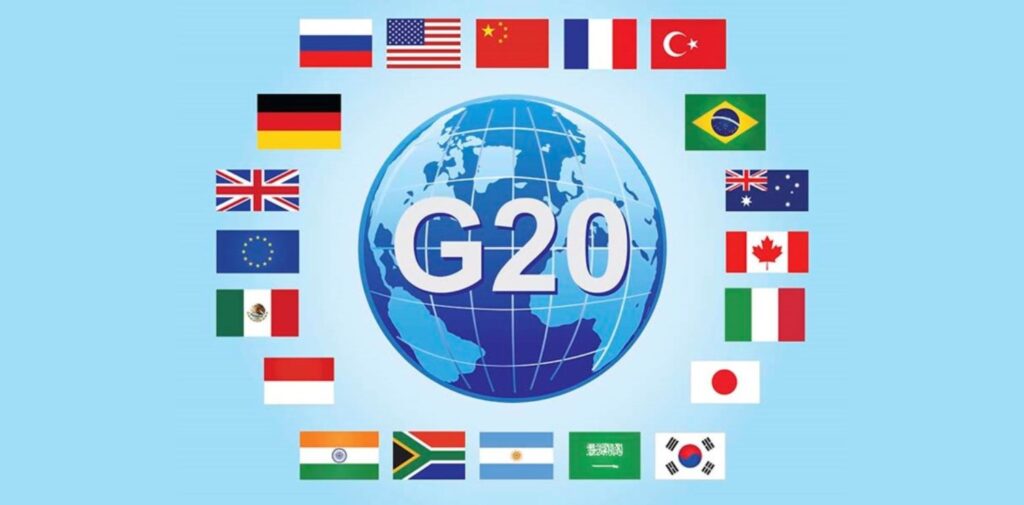The Group of Twenty (G-20) is an international forum comprising the world’s major economies, both advanced and emerging. The G-20 Summit, an annual meeting of its leaders, serves as a pivotal platform for addressing global economic challenges, promoting cooperation, and fostering discussions on various other critical issues such as climate change, global health, and geopolitical stability. In this article, we will delve deep into the G-20 summit, its origins, objectives, functioning, significance, and the issues it tackles, all presented point by point.
Introduction to the G-20 Summit
The G-20 is an international forum of 19 countries and the European Union (EU), representing the world’s largest economies in terms of GDP and population. The G-20 summit refers to the annual gathering of the leaders of these nations. It is one of the most influential global events and attracts attention from world leaders, policymakers, economists, business figures, and the media.
The Member Countries of G-20
The member nations of the G-20 comprise both developed and developing economies. These countries are:
- Argentina
- Australia
- Brazil
- Canada
- China
- France
- Germany
- India
- Indonesia
- Italy
- Japan
- Mexico
- Russia
- Saudi Arabia
- South Africa
- South Korea
- Turkey
- United Kingdom
- United States
Additionally, the European Union, which is represented by the European Commission and the European Central Bank, is also a member.
Together, these countries represent approximately 85% of the world’s GDP and two-thirds of the global population, making the G-20 a critical forum for addressing global economic challenges.

Origins of the G-20
The G-20 was established in 1999, in response to the financial crises that impacted emerging economies in the late 1990s. The crises revealed the need for a more inclusive and representative forum to address global economic issues. Initially, the G-20 was a meeting of finance ministers and central bank governors. However, following the global financial crisis of 2007-2008, the G-20 evolved into a leader-level summit. The first G-20 leaders’ summit took place in 2008, in Washington D.C., and has since become an annual event.
Objectives of the G-20 Summit
The G-20 summit seeks to address a broad range of global issues, with a particular focus on economic policies. However, the scope of discussions extends beyond economics, covering matters that have significant social, environmental, and geopolitical ramifications. The main objectives of the G-20 summit include:
- Economic Coordination and Stability: The primary objective of the G-20 summit is to promote economic cooperation and coordination among the world’s largest economies. It aims to foster policies that ensure global economic stability and prevent financial crises. This includes discussions on global trade, fiscal policies, exchange rates, and investment strategies.
- Sustainable Development: The G-20 summit also addresses sustainable development, with a focus on inclusive growth. It aims to tackle issues such as poverty eradication, equitable development, and social inclusion, particularly in developing economies.
- Global Health and Pandemic Response: Given the global interconnectedness, the G-20 summit has increasingly focused on issues of global health. The COVID-19 pandemic brought health issues to the forefront of G-20 discussions, with an emphasis on vaccine distribution, healthcare systems, and pandemic preparedness.
- Climate Change and Environmental Sustainability: Climate change is one of the central challenges of the 21st century. The G-20 summit has been instrumental in advancing climate change discussions, especially on reducing carbon emissions, transitioning to green energy, and adapting to the effects of climate change.
- Geopolitical Stability and Security: The G-20 also serves as a platform to discuss geopolitical issues, such as regional conflicts, security challenges, and the impact of global political tensions on economic stability.

Structure and Functioning of the G-20
The G-20 summit operates through a complex structure of meetings, working groups, and official events that culminate in the annual summit. Here’s a breakdown of how the G-20 functions:
- Presidency and Troika System: The G-20 presidency rotates every year among its member countries. The country holding the presidency is responsible for setting the agenda for the year and hosting the summit. The “Troika” system consists of the current, previous, and incoming presidencies. This system ensures continuity in the work of the G-20.
- The Annual Summit: The G-20 summit itself is typically held in the autumn and is attended by the heads of state or government of the member nations. The summit discussions are closed-door affairs but are heavily influenced by the outcomes of various preparatory meetings.
- Working Groups and Ministerial Meetings: In addition to the summit, G-20 members also meet in various working groups and ministerial-level meetings. These discussions are held throughout the year and focus on specific topics, such as finance, trade, labour, and development.
- Non-G-20 Participants: While the summit is primarily a meeting of G-20 members, the host country also invites representatives from other international organizations, such as the United Nations, the World Bank, the International Monetary Fund (IMF), and the World Trade Organization (WTO). Heads of state from invited countries may also participate as guests.
- Role of International Organizations: Organizations like the IMF, World Bank, and WTO play key roles in the discussions at the G-20 summit. They provide technical expertise, data, and policy recommendations to the leaders to guide discussions and decisions on global economic and social issues.
Key Areas of Focus in Recent G-20 Summits
While the focus of each summit varies according to the pressing issues of the time, several themes have consistently emerged as central to G-20 discussions.
- Economic Growth and Trade: The global economy has long been a core issue for the G-20 summit. The leaders discuss policies to promote global economic growth, trade liberalization, and the removal of trade barriers. These discussions have led to initiatives that aim to resolve trade disputes and encourage multilateral cooperation.
- Climate Change and Green Economy: As the global threat of climate change intensifies, G-20 leaders have increasingly focused on policies that promote a transition to a green economy. This includes commitments to reduce greenhouse gas emissions, invest in renewable energy, and promote sustainable practices.
- Global Health and COVID-19: The COVID-19 pandemic has shifted the focus of G-20 meetings toward global health responses. Leaders have worked on plans for equitable vaccine distribution, ensuring global healthcare access, and strengthening the resilience of health systems in the face of future pandemics.
- Digital Transformation: With rapid technological advancements, G-20 summits have included discussions on digital transformation, the digital economy, cybersecurity, and the role of artificial intelligence (AI) in reshaping the global economy.
- Geopolitical Tensions: In addition to economic issues, the G-20 also provides a platform for addressing international political tensions, such as conflicts in the Middle East, the Indo-Pacific region, and the effects of the Russia-Ukraine war on global stability.

Challenges Facing the G-20
Despite its influence, the G-20 faces several challenges in fulfilling its objectives. Some of the main challenges include:
- Divergent National Interests: The member countries of the G-20 represent a wide range of economic interests, political ideologies, and developmental priorities. Reconciling these differences can be challenging, as countries often have competing national interests that complicate consensus-building.
- Global Inequality: While the G-20 aims to foster inclusive growth, disparities in income and wealth, particularly between developed and developing countries, remain a persistent issue. Ensuring that all countries benefit equally from G-20 initiatives remains a complex challenge.
- Climate Change Action: Although the G-20 has made strides in addressing climate change, some member countries, particularly those with large fossil fuel industries, have been resistant to stronger commitments. This complicates efforts to tackle global warming effectively.
- Geopolitical Tensions: Tensions among G-20 members—such as the ongoing trade disputes between the United States and China, or Russia’s geopolitical actions—can hinder cooperation and undermine the potential for global consensus; s.
Conclusion
The G-20 summit has evolved into one of the most influential global gatherings, bringing together the world’s major economies to address pressing issues and foster international cooperation. As the global landscape continues to evolve, the G-20 will remain a vital forum for discussions on economic growth, sustainable development, global health, and geopolitical stability. While it faces challenges, the G-20’s role in shaping the global economic order and tackling global issues is likely to become even more critical in the coming years. Its ability to promote dialogue and build consensus across diverse economies will be key to addressing the complex and interconnected challenges of the future.




